A Pictorial Visit To The Morgue (Warning – Graphic Images!)
Death investigations are conducted by both police investigators and medical examiners or coroners. Each city, county, and/or state determines whether or not to utilize a coroner or medical examiner system.
A coroner is an elected official and may or may not be a medical doctor. In fact, even the ticket-taker at the local Bijou Theater could be elected as coroner in some places, as long as he/she meets the local requirements. In some locations the requirements are minimal, such as being a citizen of the area for a year, and being of legal voting age with a non-violent criminal history.
In some counties, in California for example, the county sheriff also serves as coroner. Elected corners with no medical background employ pathologists to conduct autopsies.
A medical examiner is a medical doctor that has been hired by a city or county to conduct autopsies and investigate the cause(s) of suspicious deaths.
The police are in charge of all murder scenes, but medical examiners and coroners are in charge of the body. Medical examiners and coroners do not interrogate suspects and detectives do not examine bodies.
Bodies are placed in sealed body bags and delivered to the morgue in specially equipped vehicles.
Upon arrival at the morgue, bodies are placed on gurneys and rolled onto scales where they’re weighed.
After weighing, the body is placed inside a cold room until autopsy. Black or dark gray, leak-resistant body bags are used pre-autopsy. The paper bag resting on the body of the murder victim at the top of the photo contains the victim’s personal belongings.
Autopsy station
Former Butler County, Ohio coroner, Dr. Richard Burkhardt, M.D., at autopsy station.
Carts containing the necessary tools of the trade are wheeled next to the autopsy station within easy reach for the pathologists.
Bone saw for removing the top of the skull, and sometimes to make the rib cuts for access to internal organs.
As organs are removed they’re placed on hanging scales for weighing.
“If a medical examiner were allowed to do only one thing during an autopsy, that one thing should be to weigh the heart of the victim. The weight of a heart is key to most of death’s mysteries.” Dr. Richard Burkhardt, Butler County Ohio Corner. (Excerpt from Police Procedure and Investigation by Lee Lofland)
Once the autopsy is complete, an assistant begins the process of closing. Pictured above, an attendant replaces the top of the skull and then stitches the scalp back in place.
Pathologists make a “Y” incision, starting at each shoulder, meeting at the bottom of the sternum (the xiphoid process is the cartilaginous/bony tip at the base of the sternum), continuing to the pubic bone, typically bypassing the navel.
Body – post autopsy.
Samples of organs are often kept for future examination, and/or DNA testing.
Cold rooms also store amputated body parts. The gray trays on the right contain severed limbs. White, paper-like body bags, like the one lying on the gurney in the rear of the cold room above, are used post-autopsy for bodies waiting to be transported to funeral homes.
*Attendees of the first Writers’ Police Academy were treated to a behind the scenes tour of the morgue featured above. Hmm…only writers would consider a trip to the morgue as a treat.

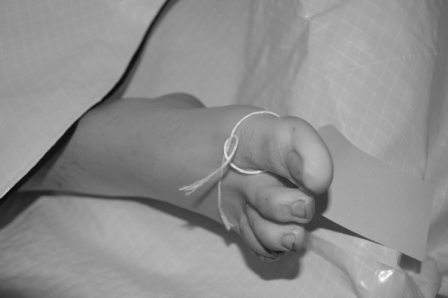
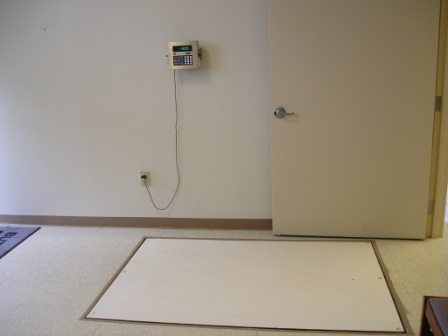
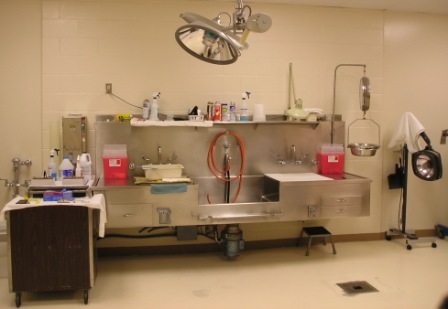
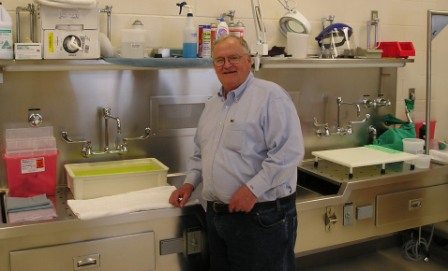
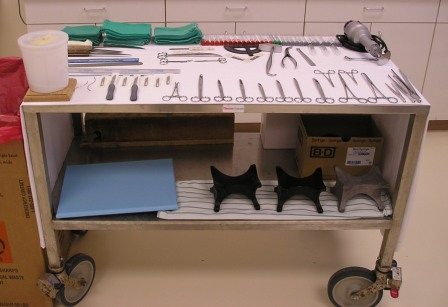
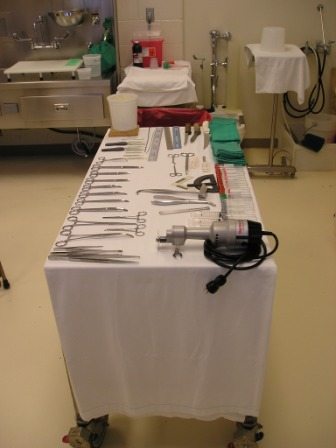
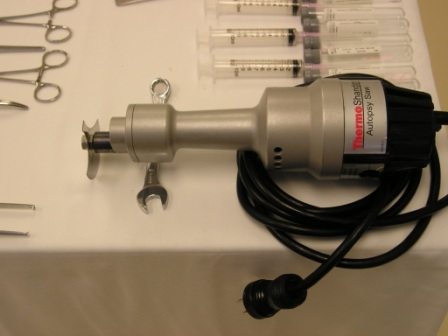
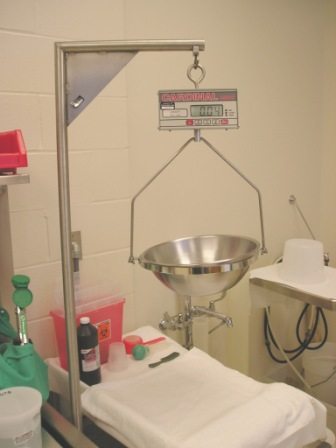
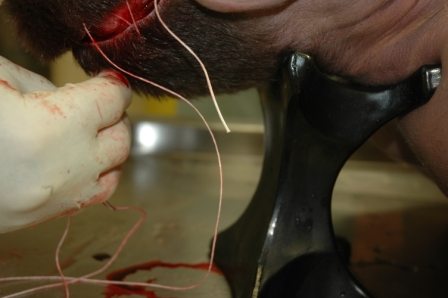
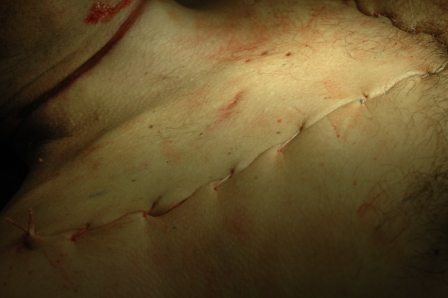

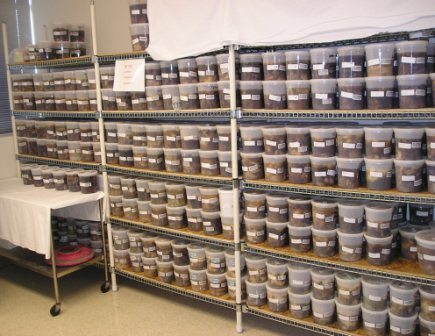



Thanks, Lee!
A diener is usually the morgue attendant whose job is to help out in the morgue—retrieving the bodies for the pathologists, cleaning up after the autopsy, and even “closing up” after the doctor completes the autopsy. The photo above that shows the scalp-stitching, is a picture of a diener’s hands as he’s performing the “closing” of the body of a homicide victim. This particular diener is a retired police officer.
Pathologists’ Assistants normally possess a Bachelors or Masters Degree in Anatomical Pathology, or a degree in a related field with a certification as a Pathologists’ Assistant. And they work under the supervision of a medical doctor/pathologist. Not all dieners are held to this standard, and those who aren’t do not perform autopsies.
Some people still refer to anyone working in the morgue who’s not a pathologist, as a diener. But the two are separated by formal education, training, and certification.
I’m not aware of any morgue where someone who’s not a medical doctor/pathologist/certified pathologists’ assistant performs a complete autopsy. I have seen dieners in state morgues make the “Y” incision, remove the vitreous fluid samples from the eyes, cut the ribs, and even remove the top of the skull. But when it came to dissection and evisceration, that was the job of a trained medical doctor/pathologist or a pathologists’ assistant.
There are people who examine tissue samples and slides who are not pathologists/doctors—histologists and cytologists.
Oh, the Lahey Clinic in the Boston area employees dieners who have no formal education beyond high school or GED. I don’t think the courts would accept their “cause of death” findings… 🙂
Any word on what a diener does? I once worked at a hospital where much of the actual autopsy work – cutting, organ removal and such – were done by a diener. Pathology docs then came in and looked at tissues. Is that only in hospitals, or also in city/county morgues?
I know, I know – I’m a day late to comment on this excellent post. Thank you, Lee, for writing this up — with photos, too. Only writers, right? 😉
Anyway, NYC ME Jonathan Hayes took MWA-NY on a tour of the ME’s world. A lot in your post looks familiar and sounds familiar thanks to his excellent tour.
One difference between the two jurisdictions is in the type of containers to save organs for examination. Let’s just say that, thanks to the NYC tour, I’ll never look at a bucket of chicken the same way again. =:-o (Great for the diet!)
Looking forward to the WPA, BTW! Seeya soon.
Jan, you know how sometimes we drive ever so slowly around a speed bump just to avoid the “bump” in the road. Same thing here. It’s a much easier and smoother trip south if you avoid the bellybutton. So they “drive” around it.
Fascinating stuff. Especially the comment about weighing the heart–never heard that before, and that the naval is usually bypassed in the Y-cut. Is there a particular reason for that, Lee?
Awesome info! Thanks. I agree with Kelly.
Great article–
flagging this for future reference.